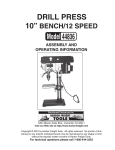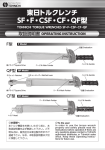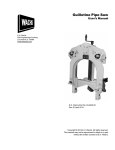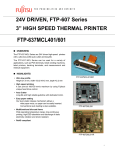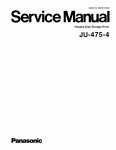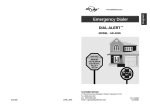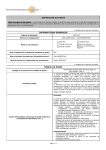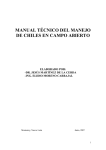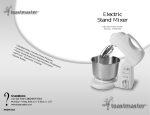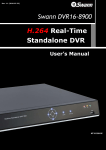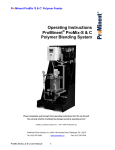Download Magna Operators Manual Std dryer - 2005->
Transcript
MAGNA GRAIN DRYERS M MO OD DE ELL 22000055 -->> JULY 2005 Handbook for the use and maintenance of the dryer Revision July 2005 Page 2 of 36 1 INTRODUCTION TO THE MANUAL 1.1 FOREWORD This manual is provided to give you the necessary operating and maintenance instructions to obtain the best performance and working life for your dryer. Please read this manual thoroughly. Understand what each control is for and how to use it. Observe all safety precautions decaled on the machine and noted throughout the manual for safe operation. DO NOT CARRY OUT MAINTENANCE WORK AND/OR REPAIRS UNTIL THE TRACTOR ENGINE IS STOPPED AND THE PTO DISCONECTED OR IF AN ELECTRIC DRIVE UNIT THE MAIN POWER SWITCH TURNED TO OFF. DO NOT UNDER ANY CIRCUMSTANCES ENTER THE DRYER THROUGH THE INSPECTION HATCH UNTIL THE TRACTOR IS TURNED OFF AND THE PTO SHAFT IS COMPLETELY DISCONTECTED OR IF AN ELECTRIC DRIVE UNIT THE MAIN POWER SWITCH TURNED TO OFF. FAILURE TO FOLLOW THIS INSTRUCTION MAY CAUSE SERIOUS INJURY. EXPLANATION – SHOULD THE AGITATOR ARM RECIRCULATE WHILST THE OPERATOR IS ENTERING THE DRYER OR INSIDE THE DRYER If any assistance or additional information is needed, contact your authorized OPICO dealer. This manual is divided into the following sections: 1) Introduction 2) General Information 3) Preparing The Dryer For Operation 4) Loading And Operation 5) Maintenance 6) Safety Warnings 7) Trouble Shooting 8) Storage 9) Wiring Diagrams For safety and to obtain the performance of which these machines are capable we recommend that the operator should read this manual carefully before initial start up at the beginning of each season and when changing to a new crop type. Handbook for the use and maintenance of the dryer Revision July 2005 Page 3 of 36 1.2 INDEX 1 1.1 1.2 1.3 1.4 2 2.1 2.2 2.3 2.4 2.4.1 2.4.2 2.4.3 2.4.4 3. 3.1 3.2 3.3 3.4 3.5 3.6 3.7 4 4.1 4.2 4.3 4.4 4.5 4.6 4.7 5 5.1 5.2 6 6.1 6.2 6.3 6.3.1 6.4 6.5 7 7.1 7.2 7.3 7.4 7.5 7.6 7.7 7.8 8 9 INTRODUCTION TO THE MANUAL............................................................................................ 2 FOREWORD................................................................................................................................ 2 INDEX ......................................................................................................................................... 3 DEFINITION OF SYMBOLS......................................................................................................... 4 SAFE WORKING ENVIRONMENT .............................................................................................. 4 GENERAL INFORMATION .......................................................................................................... 5 OVERVIEW .................................................................................................................................. 5 DRYER IDENTIFICATION ........................................................................................................... 5 DRYER COMPONENTS .............................................................................................................. 6 THEORY OF DRYING ................................................................................................................. 7 HEATING THE GRAIN................................................................................................................. 7 COOLING THE GRAIN ................................................................................................................ 7 RECOMMENDED DRYING TEMPERATURES ........................................................................... 8 TEMPERATURE CONVERSION CHARTS ............................................................................... 12 PREPARING THE DRYER FOR OPERATION.......................................................................... 13 SITING THE DRYER.................................................................................................................. 13 POSITIONING THE TOP FOLD DOWN AUGER....................................................................... 14 PREPARING FOR TRANSPORT............................................................................................... 16 LOADING AUGER HOPPER ..................................................................................................... 16 DIESEL FUEL SUPPLY ............................................................................................................. 16 CONNECT THE PTO SHAFT TO THE TRACTOR .................................................................... 16 CONTROLS ............................................................................................................................... 17 DRYER OPERATION................................................................................................................. 18 CONTROL BOARD .................................................................................................................... 18 PLENUM & GRAIN TEMPERATURE THERMOSTATS............................................................. 19 PLENUM SAFETY CONTROL................................................................................................... 19 THERMIC SAFETY .................................................................................................................... 19 LOADING AND OPERATING .................................................................................................... 20 HOW TO GET THE BEST PERFORMANCE OUT OF YOUR DRYER...................................... 21 FUEL NOZZLE SELECTION AND SETTINGS………………………………………………………22 MAINTENANCE ......................................................................................................................... 23 POINTS TO LUBRICATE........................................................................................................... 23 END OF SEASON OPERATIONS ............................................................................................. 24 SAFETY WARNINGS................................................................................................................. 25 SAFETY PRINCIPLE ................................................................................................................. 25 WARNINGS AND DANGERS .................................................................................................... 26 SAFETY GUARDS AND WARNING LOGOS ............................................................................ 27 EMERGENCY STOP BUTTON.................................................................................................. 27 RESIDUAL RISKS...................................................................................................................... 27 NOISE LEVELS ......................................................................................................................... 27 TROUBLE SHOOTING .............................................................................................................. 28 THE BURNER ............................................................................................................................ 28 DEFLECTOR AND ELECTRODES............................................................................................ 29 HEAT UNIT AIR FLAP ADJUSTMENT ...................................................................................... 30 BURNER DOES NOT LIGHT..................................................................................................... 31 DIESEL SUPPLY FAILURE ....................................................................................................... 31 SMOKE OR EXCESS DIESEL FUMES ..................................................................................... 31 THE AIR MIXTURE IS TOO LEAN AND THE FLAME VERY BRIGHT IN COLOUR................. 31 FUEL CIRCUIT…………………………………………………………………………………………..32 STORAGE.................................................................................................................................. 32 WIRING DIAGRAMS.................................................................................................................. 32 ENCLOSED WITH THIS HANDBOOK DECLARATION OF CONFORMITY SUPPLIED BY THE MANUFACTURER PRODUCT REGISTRATION CARD Handbook for the use and maintenance of the dryer Revision July 2005 Page 4 of 36 1.3 DEFINITION OF SYMBOLS Symbols are used in this handbook to highlight parts of its content, which are of special importance for safety, use and maintenance SYMBOL MEANING DESCRIPTION ATTENTION Section of text which includes an instruction that that requires attention DANGER This symbol requires you to pay special attention because your safety is involved USE Explanation of the correct use of the dryer MAINTENANCE Maintenance Instructions 1.4 SAFE WORKING ENVIRONMENT Read and understand the operators manual before operating the unit Always disconnect the PTO shaft or if an electric drive unit turn the main power switch to off before adjusting, lubricating, servicing or cleaning Keep all shields and safety devices in place Keep children, visitors and untrained personnel away from the machine while in operation Keep hands, feet and clothing away from moving parts Keep unit level when operating DO NOT UNDER ANY CIRCUMSTANCES ENTER THE DRYER THROUGH THE INSPECTION HATCH UNTIL THE TRACTOR IS TURNED OFF AND THE PTO SHAFT IS COMPLETELY DISCONTECTED OR IF AN ELECTRIC DRIVE UNIT THE MAIN POWER SWITCH TURNED TO OFF. FAILURE TO FOLLOW THIS INSTRUCTION MAY CAUSE SERIOUS INJURY. EXPLANATION – SHOULD THE AGITATOR ARM RECIRCULATE WHILST THE OPERATOR IS ENTERING THE DRYER OR INSIDE THE DRYER Handbook for the use and maintenance of the dryer Revision July 2005 Page 5 of 36 2 GENERAL INFORMATION 2.1 OVERVIEW All instructions relating to position are as viewed from the front of the dryer looking toward the back of the machine. 2.2 DRYER IDENTIFICATION The Identification Plate and CE marking of the machine is placed on the left side of the draw-bar. The identification plate must not be tampered with, covered over or modified in any way. Should the plate become damaged or lost you should request a replacement as soon as reasonable possible. Picture 2.2 IDENTIFICATION PLATE Handbook for the use and maintenance of the dryer Revision July 2005 Page 6 of 36 2.3 DRYER COMPONENTS Picture 2.3 DRYER COMPONENTS TABLE 1) Discharge Chute 10) Grain Cleaner Discharge 2) Vertical Auger 11) Grain Sampler Outlet 3) Plenum Chamber 12) Loading Auger 4) Air Duct 13) Belt Drive 5) Fan 14) Centre Auger Gearbox 6) Heat Unit 15) Adjustable Support Jacks 7) Agitator Gearbox 16) PTO Shaft 8) Agitator Support Rollers 17) Control Board 9) Agitator Arm 18) Main Drive Shaft Handbook for the use and maintenance of the dryer Revision July 2005 Page 7 of 36 2.4 THEORY OF DRYING 2.4.1 HEATING THE GRAIN Combinable crop drying has two basic stages: 1. The diffusing of internal moisture to the surface of the grain, bean or seed. Followed by: 2. The removal of the created external moisture by air flow. The grain temperature largely establishes this rate of diffusion and must be controlled not to exceed a rate that could result in a ruptured seed. Removal of the exterior moisture is dependant upon air flow and air temperature. These two stages must be balanced to produce the quality dried crop. The balance is accomplished quite simply in the Magna Grain Dryer with its uniform circulation, regulated heat and controlled air-flow. 2.4.2 COOLING THE GRAIN It is very important to cool grain. Grain to be stored should be cooled after drying to within 15 degrees F of atmospheric temperature or 10 degrees F of grain already in the storage bin. Moisture migration from air to grain will occur if the grain is not cooled within these limits. Handbook for the use and maintenance of the dryer Revision July 2005 Page 8 of 36 2.4.3 RECOMMENDED DRYING TEMPERATURES CROP TYPE BARLEY Feed Malting/Seed MOISTURE CONTENT & POINTS OF INTEREST Below 21% Above 22% PLENUM TEMPERATURE MAXIMUM FINAL GRAIN TEMPERATURE FINAL STORAGE LEVEL 180 - 200°F 120 - 150°F 110 - 130°F 120°F 105°F 105°F 14% If light samples are experienced Maximum Plenum Temperature should not exceed 140°F WARNING Great care should be taken with the storage of barley grown for malting or seed between the actual harvesting of the material and the drying of it. Harvested crop must only be stored before drying for the minimum amount of time. It is recommended that the crop is stored so that the maximum depth does not exceed 2 feet. CROP TYPE MOISTURE CONTENT & POINTS OF INTEREST PLENUM TEMPERATURE MAXIMUM FINAL GRAIN TEMPERATURE FINAL STORAGE LEVEL 160 - 200°F 120°F 8% OILSEED RAPE Up to 17% SPECIAL NOTES 1. Plenum temperatures of up to 200°F have been used without apparent oil/quality loss 2. Excessive heat gives slower drying – cooling prolonged 3. Mature crops dry relatively easily 4. Desiccated early crops may contain 30% volume of immature seeds which are less easily dried 5. With moisture content above 17% - for every 2% increase in moisture content, reduce plenum temperature by 10°F for the initial drying period CROP TYPE OILSEED RAPE Seed MOISTURE CONTENT & POINTS OF INTEREST Reduce plenum temperature by 10°F PLENUM TEMPERATURE MAXIMUM FINAL GRAIN TEMPERATURE FINAL STORAGE LEVEL 120 - 150°F 105°F 8% Handbook for the use and maintenance of the dryer Revision July 2005 Page 9 of 36 FINAL STORAGE MAXIMUM FINAL GRAIN LEVEL TEMPERATURE HERBAGE SEEDS (SAFE DRYING AIR TEMPERATURES FOR 90% GERMINATION) (Grass Seed) PRG/IRG Up to 25% 13% 130°F 90°F Between 25% – 30% 13% 120°F 90°F Between 30% – 35% 13% 110°F 90°F Between 35% – 40% 13% 100°F 90°F CROP TYPE MOISTURE CONTENT & POINTS OF INTEREST PLENUM TEMPERATURE NOTES * Always grown for seed * Grass seed does not flow easily over 22% moisture content * Polish the dyer prior to use with dried barley or other dry grain BEANS – see Peas/Field Beans CROP TYPE LINSEED Oil extraction and/or seed MOISTURE CONTENT & POINTS OF INTEREST Up to 15% PLENUM TEMPERATURE MAXIMUM FINAL GRAIN TEMPERATURE FINAL STORAGE LEVEL 120 - 150°F 120°F 8% *For every 2% increase in moisture content reduce plenum temperature by 10°°F CROP TYPE OATS Feed Seed MOISTURE CONTENT & POINTS OF INTEREST 90 - 120°F 105°F 8% PLENUM TEMPERATURE MAXIMUM FINAL GRAIN TEMPERATURE FINAL STORAGE LEVEL 150 - 200°F 110 - 150°F 130°F 105°F 14% 14% NOTE Oats for feed use can stand plenum temperatures up to 220°F. Handbook for the use and maintenance of the dryer Revision July 2005 Page 10 of 36 CROP TYPE MOISTURE CONTENT & POINTS OF INTEREST PLENUM TEMPERATURE MAXIMUM FINAL GRAIN TEMPERATURE FINAL STORAGE LEVEL PEAS/FIELD BEANS Processing / 14% 110 - 120°F 105°F Protein NOTE In general protein is not affected by heat but excessive heat will cause splitting damage Seed Below 24% 14% 90 - 110°F 105°F Seed Above 24% 14% 70 – 90°F 105°F Seed Above 27% 14% No heat to 50°F 105°F DIRECT HARVESTED 1. Can experience handling problems over 25% moisture content 2. Do not use loading auger over 25% moisture content (see below) 3. Special note – clean out the centre auger bin bottom after each load. This crop carries a lot of surface dirt which in the re-circulation process will find its way to the bin bottom well and create an extremely abrasive paste. This will shorten the life of the centre auger dramatically if the recommended cleaning process is not carried out. DRYING FROM STORE 1. This crop is susceptible to splitting if excessive heat is used 2. Increase temperature in 5°F stages and check for splits to a maximum of 110°F plenum temperature : No heat - 110°F CROP TYPE WHEAT Feed Milling MOISTURE CONTENT & POINTS OF INTEREST Below 25% Above 25% Seed PLENUM TEMPERATURE MAXIMUM FINAL GRAIN TEMPERATURE FINAL STORAGE LEVEL 180 - 200°F 150 - 180°F 140 – 170°F 100 - 130°F 140°F 120°F 120°F 105°F 14% 14% 14% 14% SPECIAL NOTES 1. High gluten wheats mean slower drying 2. Wet cereals in general i.e. over 27% moisture content – dry carefully do not exceed Grain Final Safe Temperature. If this is apparent, stop the burner, allow dryer to continue circulating grain until cool, then re-light the burner and complete the drying process. 3. Seed wheat over 27% moisture content – use no heat to a maximum of 105°F plenum until moisture content is below 20%, then continue with care using a plenum temperature of 120°F maximum. Handbook for the use and maintenance of the dryer Revision July 2005 Page 11 of 36 CROP TYPE MOISTURE CONTENT & POINTS OF INTEREST LUPINS Drying for Seed PLENUM TEMPERATURE MAXIMUM FINAL GRAIN TEMPERATURE FINAL STORAGE LEVEL no heat to 120°F * Furry seed – may generate fluff in handling * Very tough skin * Pre-drying treatment – pre-cleaning helpful if not essential METHOD 1. Polish dryer with barley prior to handling 2. Be careful if moisture content 23% - 24% - augers may not handle 3. Recommended plenum temperatures no heat - 105°F - 120°F ABSOLUTE MAXIMUM Handbook for the use and maintenance of the dryer Revision July 2005 Page 12 of 36 2.4.4 TEMPERATURE CONVERSION CHART EG 120°F = 48.9°C OR 120°C = 248°F 0 ~ 90 °C -17.8 -15.0 -12.2 -9.4 -6.7 -3.9 -1.1 1.7 4.4 7.2 10.0 10.6 11.1 11.7 12.2 12.8 13.3 13.9 14.4 15.0 15.6 16.1 16.7 17.2 17.8 18.3 18.9 19.4 20.0 20.6 21.1 21.7 22.2 22.8 23.3 23.9 24.4 25.0 25.6 26.1 26.7 27.2 27.8 28.3 28.9 29.4 30.0 30.6 31.1 31.7 32.2 91 ~ 141 °F 0 5 10 15 20 25 30 35 40 45 50 51 52 53 54 55 56 57 58 59 60 61 62 63 64 65 66 67 68 69 70 71 72 73 74 75 76 77 78 79 80 81 82 83 84 85 86 87 88 89 90 °C 32.0 41.0 50.0 59.0 68.0 77.0 86.0 95.0 104.0 113.0 122.0 123.8 125.6 127.4 129.2 131.0 132.8 134.6 136.4 138.2 140.0 141.8 143.6 145.4 147.2 149.0 150.8 152.6 154.4 156.2 158.0 159.8 161.6 163.4 165.2 167.0 168.8 170.6 172.4 174.2 176.0 177.8 179.6 181.4 183.2 185.0 186.8 188.6 190.4 192.2 194.0 32.8 33.3 33.9 34.4 35.0 35.6 36.1 36.7 37.2 37.8 38.3 38.9 39.4 40.0 40.6 41.1 41.7 42.2 42.8 43.3 43.9 44.4 45.0 45.6 46.1 46.7 47.2 47.8 48.3 48.9 49.4 50.0 50.6 51.1 51.7 52.2 52.8 53.3 53.9 54.4 55.0 55.6 56.1 56.7 57.2 57.8 58.3 58.9 59.4 60.0 60.6 142 ~ 260 °F 91 92 93 94 95 96 97 98 99 100 101 102 103 104 105 106 107 108 109 110 111 112 113 114 115 116 117 118 119 120 121 122 123 124 125 126 127 128 129 130 131 132 133 134 135 136 137 138 139 140 141 195.8 197.6 199.4 201.2 203.0 204.8 206.6 208.4 210.2 212.0 213.8 215.6 217.4 219.2 221.0 222.8 224.6 226.4 228.2 230.0 231.8 233.6 235.4 237.2 239.0 240.8 242.6 244.4 246.2 248.0 249.8 251.6 253.4 255.2 257.0 258.8 260.6 262.4 264.2 266.0 267.8 269.6 271.4 273.2 275.0 276.8 278.6 280.4 282.2 284.0 285.8 °C 61.1 61.7 62.2 62.8 63.3 63.9 64.4 65.0 65.6 66.1 66.7 67.2 67.8 68.3 68.9 69.4 70.0 70.6 71.1 71.7 72.2 72.8 73.3 73.9 74.4 75.0 75.6 76.1 76.7 77.2 77.8 78.3 78.9 79.4 82.2 85.0 87.8 90.6 93.3 96.1 98.9 101.7 104.4 107.2 110.0 112.8 115.6 118.3 121.1 123.9 126.7 °F 142 143 144 145 146 147 148 149 150 151 152 153 154 155 156 157 158 159 160 161 162 163 164 165 166 167 168 169 170 171 172 173 174 175 180 185 190 195 200 205 210 215 220 225 230 235 240 245 250 255 260 287.6 289.4 291.2 293.0 294.8 296.6 298.4 300.2 302.0 303.8 305.6 307.4 309.2 311.0 312.8 314.6 316.4 318.2 320.0 321.8 323.6 325.4 327.2 329.0 330.8 332.6 334.4 336.2 338.0 339.8 341.6 343.4 345.2 347.0 356.0 365.0 374.0 383.0 392.0 401.0 410.0 419.0 428.0 437.0 446.0 455.0 464.0 473.0 482.0 491.0 500.0 Handbook for the use and maintenance of the dryer Revision July 2005 Page 13 of 36 3 PREPARING THE DRYER FOR OPERATION 3.1 SITING THE DRYER Select a site as level as possible 50 feet (15 metres) from inflammable buildings. It is preferable to set the machine with the fan facing toward the prevailing wind. If the dryer is being set on a level concrete slab simply lower the adjustable jacks, raising the wheels slightly off the ground, bringing the machine to a level position. It is important that the central auger is vertical. Use the spirit levels that are positioned on the dryer transport chassis. If the dryer has been placed straight on to soil then a board of at least 2" x 8" x 12" should be placed under each leg. Handbook for the use and maintenance of the dryer Revision July 2005 Page 14 of 36 3.2 POSITIONING THE TOP FOLD DOWN AUGER THERE IS A CORRECT METHOD THAT MUST BE FOLLOWED: Step One: At the rear of the dryer there is a 4mtr long round bar mounted vertically that controls the unloading plate. This is locked in transport position by a large lock screw on the second ring. This screw must be loosened off to allow the bar to float up with the extending sheets. Step Two: Raise the external extending sheets by approximately 200-300mm, using the top extension winch. Step Three: First examine the illustration (Fig 3A) Climb the external ladder and stand on the plenum. Using the lever marked 1, pull the over-centre mechanism bringing the folding auger toward the centre of the dryer. Lock the lever in position using the wing nut item number 2. FAILURE TO FOLLOW STEP TWO WILL RESULT IN MATERIAL DAMAGE TO THE SIDE SHEETS OF THE DRYER. FIG 3A - VERTICAL AUGER HINGE OVER-CENTRE MECHANISM Handbook for the use and maintenance of the dryer Revision July 2005 Page 15 of 36 3.2 POSITIONING THE TOP FOLD DOWN AUGER Step Four: Continue to raise the side sheets that will carry the folding part of the vertical auger with them until the side sheets are 50-100mm from the top of their movement range. Step Five: Using the vertical auger winch (beside the control cabinet) raise the folding auger into its vertical position. Once the auger is correctly positioned climb the ladder and tighten up the wing nut item 3 in Fig 3b. Step Six: Continue to raise the external extending sheets fully. Taking care not to apply excessive force. Mount the four safety pins below the extension support bars. Step Seven: Check that the vertical rod controlling the unloading gate as mentioned in step one is in the correct position and opens/closes freely. FIG 3B - VERTICAL AUGER FOLDING DURING WORK THE WINCH WIRE TO THE TOP AUGER SHOULD NOT BE UNDER TENSION. Handbook for the use and maintenance of the dryer Revision July 2005 Page 16 of 36 3.3 PREPARING FOR TRANSPORT TO PREPARE THE DRYER FOR TRANSPORT FOLLOW ALL THE STEPS ABOVE IN REVERSE ORDER WITH ONE ADDITIONAL STEP: First Step: To start the lowering of the top auger extension pull the wire that is positioned at the rear of the dryer and has at its end a round steel ring. Obviously you need to undo the wing nut item 3 in Fig 3b first. 3.4 LOADING AUGER HOPPER Using the appropriate winch gently lower the loading auger into the horizontal position. In the process checking that the driving lugs do not directly hit each other. adjust the support feet at the end of the hopper and check the inner/outer auger sections fit properly and are sealed to prevent grain loss. 3.5 DIESEL FUEL SUPPLY The diesel tank is located on the left hand side of the dryer. The fuel supply to the burner has a filter on the suction side. The filter should be replaced as required, depending on usage and cleanliness of diesel supply. The fuel pump is factory set at 12 bar pressure for diesel fuel. 3.6 PTO DRIVE SHAFT Connect the pto shaft to the tractor. Check that the angle between the pto of the tractor and the input pto of the dryer is as level as possible to minimise pto shaft vibration. NOTE; the tractor should not be connected to the drawbar of the dryer during dryer operation. Handbook for the use and maintenance of the dryer Revision July 2005 Page 17 of 36 3.7 CONTROLS 2 3 6 4 1. Grain sampler 2. Top extension support 5 3. Grain Temp Probe 9 7 1 4. Plenum Temp Probe 5. Plenum High Limit Probe 8 6. Generator 7. Control Board 10 8. Emergency Stop 12 11 9. Fan clutch 10. Vertical auger winch 11. Intake auger clutch 12. Jack stand Picture 3.7 CONTROLS Handbook for the use and maintenance of the dryer Revision July 2005 Page 18 of 36 4 DRYER OPERATION 4.1 CONTROL BOARD 1. Plenum Temp Thermostat 3 2 1 2. Volt meter 3. Grain Temp Thermostat 4. Ignition Start/Stop 5. Power indicator 6 6. Isolator switch 4 5 7. Hour clock 7 Picture 4.1 CONTROL BOARD OUTER 8. Transformer 9 8 9. Plenum Safety Thermostat 10. Relay 11. Burner Contactor 10 11 12 13 12. Isolator switch 13. Fuse 14. Burner Overload 14 15 Picture 4.2 CONTROL BOARD INNER 15. Terminal block Handbook for the use and maintenance of the dryer Revision July 2005 Page 19 of 36 4.2 PLENUM & GRAIN TEMPERATURE THERMOSTATS Recommended operating temperatures - Section2.4.3 Plenum & Grain thermostats are factory set to operate in °F and have one temp setting. Press ‘P’ – the last temperature set point “SP 1” used will appear on the display, using the ‘↑ ‘ key to raise or ‘↓’ key to lower the temperature setting °F. The change will appear on the display, when the desired temperature appears on the display, press ‘P’ this will save the new setting and return to the current temperature reading on the probe. When operating, a light above the symbols ‘ - = + ’ will indicate where the actual temperature reading is in relation to the preset temperature. Ie If the grain temp setting is 112°F and the grain probe is currently reading 102°F the red light will illuminate above the ‘ – ‘ symbol, when the grain temperature reaches the set temperature 112°F a green light will illuminate above the ‘ = ‘ symbol. 4.3 PLENUM SAFETY CONTROL The plenum safety control thermostat is mounted inside the control panel, it safeguards against excessive plenum temperatures, it’s temperature probe is positioned in the plenum chamber. During operation, the dryer checks the safety thermostat to make certain the plenum temperature falls within the safe operating range. If so, operation continues. Should the thermostat open at any time during operation, power to the control board will be interrupted, halting operation of the dryer. The safety thermostat operates in °C and should be set approx 30°C above the running Plenum Air Temperature setting (Note; Plenum temperature is °F, see temp conversion chart) ie Plenum temperature set at 180°F – set safety thermostat at 112°C 4.4 THERMIC SAFETY The thermic safety indicates if any of the electric motor circuit breakers have tripped. This protects the motor from over loading, ie if an auger was to jam. Check all the circuit breakers and reset any which have tripped – checking the driveline and motor in question. Handbook for the use and maintenance of the dryer Revision July 2005 Page 20 of 36 4.5 LOADING AND OPERATION Start the tractor and set pto speed at approximately 450 rpm. Check the diesel tank has sufficient fuel. Engage the ‘loading auger’ using the marked lever and proceed to fill the dryer. Fill the grain bin until the grain is approx 150 - 250mm below the top rim. This amount depends on initial grain moisture, as wet grain is heated it will expand. Leaving space at the top of the dryer provides the additional room needed and prevents the dryer from spilling over. Disengage the intake when the dryer is full. DO NOT LEAVE GRAIN IN THE DRYER OVERNIGHT. Grain that remains in the dryer overnight will absorb moisture and swell. This swelling can cause the vertical auger to jam. NOTE; The agitator will automatically disengage on Magna 2000 models during loading, this is to reduce the grain recirculation during loading and minimise the loading time. Engage the ‘fan’ using the marked lever. To prolong belt life it is recommended that the tractor pto speed is reduced by approximately 40% before engaging the fan drive, engage the lever slowly. When the belt drive to the fan is engaged, turn the control board power isolator to the ‘ON’ position and speed-up the pto until 380V is showing on the volt meter. The power indicator lights will illuminate, confirming all three phases are operating. Set ‘Grain & Plenum thermostats’ to the required temperatures. Ensure the plenum safety thermostat is set to the correct temperature. These temperature settings can be adjusted at any time during dryer operation. Start the ‘Burner motor’, the ignition should complete in 5-10 seconds. It may be necessary to do this two or three times to ensure the burner has started. Allow 30 seconds between each starting attempt. The green start button will illuminate when it is operating. When the grain has reached the pre-set grain temperature, the burner will shut off automatically. The fan will start cooling the crop. When the grain has cooled sufficiently, disengage the ‘Fan’ drive. Open the ‘Discharge guilotine’ to empty the grain bin. There is an emergency stop button mounted on the control board. Handbook for the use and maintenance of the dryer Revision July 2005 Page 21 of 36 4.6 HOW TO GET THE BEST PERFORMANCE OUT OF YOUR DRYER ON THE FIRST DRYING OF EACH DIFFERENT CROP TYPE ON YOUR FARM PROCEED AS FOLLOWS: Set the finished grain temperature to 125 degrees F that is well above the setting that you will finally use. Check the finished grain temperature gauge reading from time to time. When the grain temperature has achieved 100 degrees F take your first sample to check for actual grain moisture. Depending upon altitude, outside air temperature and if it is a dry or wet day you will record approximately between 17% and 20% moisture. Continue to run the dryer and take a further sample of grain at 102 degrees F. Continue in this fashion until the grain is half a percent above finished moisture content required. So if you are looking for 14% moisture content and you achieve 14½% at 108 degrees F press the button marked P, press the down arrow to bring the temperature from 125 degrees down to 108 degrees. The burner will cut off and the cooling cycle will begin, press P to save this new setting. When all the grain is cooled take a further sample before emptying the dryer to check the finished moisture content. If the finished moisture content is below 14% then you can fine-tune the finished grain temperature by decreasing the value locked into the finished grain temperature gauge by 1 degree. After two or three loads you will achieve the right balance for the particular crop type. At this point write down the plenum temperature you have used and the finishing grain temperature for that particular type as a future record. The major variable to consider is not moisture content, outside air temperature etc., but rather the plenum temperature used. There is a balance between extra heat and therefore extra fuel usage against time of drying. The recommendations given in our Crop Drying Recommendations are a good starting point. (Section 2.4.3) NOTE: WHEN DRYING ANY CROPS FOR SEED OR MALTING YOU MUST NOT USE PLENUM AIR TEMPERATURES HIGHER THAN OUR RECOMMENDATION. Handbook for the use and maintenance of the dryer Revision July 2005 Page 22 of 36 4.7 FUEL NOZZLE SELECTION AND SETTINGS There are occasions when drying temperatures required will vary significantly from the norm. For example when drying seed crops you may need to use smaller nozzles to achieve the correct temperatures. In Rape because of crop density overall air flow is reduced, heat retention is increased and again it may be necessary to use smaller nozzles. The following tables show the minimum heat rise and give an indication of the air flap rod measurements necessary. The air flap measurements will vary between machines and is for guidance only. (Adjustment details; section 7.3) Dryer Model – 1200QF Fan Speed – 1700rpm Fuel Pressure – 12 Bar (174 psi) Barley Barley Barley Low heat nozzle no 1 size Low heat air opening setting High heat nozzle no 2 size High heat air opening setting Heat rise minimum Gallons / Hr mm Gallons / HR mm F (C) 6 5 4 17 23 16 7 6 5 150 (66) 145 (63) 133 (56) 5 16 -19 7 20 – 23 22 Factory Set Dryer Model – 2000QF Fan Speed – 1620rpm Fuel Pressure – 12 Bar (174 psi) Low heat nozzle no 1 size Low heat air opening setting High heat nozzle no 2 size High heat air opening setting Heat rise minimum Heat rise maximum Gallons / Hr mm Gallons / HR mm F (C) F (C) 160 (71) 195 (90) OSR Wheat 8 8 10 10 OSR 6 22 8 16 8 17 10 23 140 (60) Factory Set Handbook for the use and maintenance of the dryer Revision July 2005 Page 23 of 36 5 MAINTENANCE Please take care not to over grease. Many of the bearings and rollers on this dryer require greasing only once per season. More harm will be done by over enthusiastic application than benefit. Picture 5.1 POINTS TO LUBRICATE MAIN SHAFT SUPPORT AND FAN 1,2,3,4 (GREASE LIGHTLY AT THE END OF EACH SEASON) OTHER SUPPORTS 5,9,14 (GREASE LIGHTLY AT 1 MONTH INTEVALS AND/OR AT THE END OF EACH SEASON) PTO SHAFTS 6,7,8,10: (GREASE ON DAILY BASIS) THE BEARING ROLLERS: (GREASE LIGHTLY EVERY 20 DAYS) CHAIN 13: (GREASE AT THE END OF EACH SEASON ) CENTRAL AUGER GEARBOX 11 (CHECK OIL AT END OF EACH SEASON) TOP AUGER SUPPORT 15: (GREASE LIGHTLY EVERY 15 DAYS.) Handbook for the use and maintenance of the dryer Revision July 2005 Page 24 of 36 5.2 END OF THE SEASON OPERATIONS CHECK CHAIN AND CHAIN TIGHTENER TENSION COVER AND PROTECT ALL THE ELECTRIC COMPONENTS FROM HUMIDITY REPLACE THE ROLLER BEARINGS OF THE TIMING BEARING RING, IF NECESSARY CLEAN THE FAN OF THE BURNER 5 (REFER TO THE DRAWING OF THE BURNER) CHECK THE VERTICAL AUGER AND THE VERTICAL TUBE FOR WEAR CHECK THE BELTS’ TENSION CHECK THE CONDITION OF THE FURNACE’S REFRACTORY MATERIAL CHECK THE CONDITION OF THE STEEL BOTTOM OF THE FURNACE CHECK THE CONDITION OF THE PROTECTION GUARD OF THE FAN SUPPORT, PLACED AT THE EXIT OF THE FURNACE FIRE MOUTH BETWEEN FURNACE AND FAN CHECK THE CONDITION OF CABLES AND WINCHES CHECK THE CONDITION OF THE PTO SHAFTS AND THEIR SAFETY GUARDS Handbook for the use and maintenance of the dryer Revision July 2005 Page 25 of 36 6 SAFETY WARNINGS In addition to the design and configuration of equipment, hazard control and accident prevention are dependent upon the awareness, concern, prudence and proper training of personnel in the operation, transport, maintenance and storage of equipment. Lack of attention to safety can result in accident, personal injury, reduction of efficiency and worst of all – loss of life. Watch for safety hazards and correct deficiencies promptly. Use the following safety precautions as a general guide to safe operations when using the machine. Additional safety precautions are used throughout this manual for specific operating and maintenance procedures. Read this manual and review the safety precautions often until you know the limitations. 6.1 SAFETY PRINCIPLE The following are general rules for the users of the machine: BEFORE USING THE MACHINE CAREFULLY READ ALL PARTS OF THIS MANUAL. REFRAIN FROM USING THE DRYER UNTIL THE ENTIRE MANUAL (AND ALL ITS ATTACHMENTS) ARE UNDERSTOOD. Handbook for the use and maintenance of the dryer Revision July 2005 Page 26 of 36 6.2 WARNINGS AND DANGERS DO NOT ALLOW ANYONE TO OPERATE THE MACHINE WHO IS NOT IN GOOD PHYSICAL AND MENTAL HEALTH. KEEP CHILDREN, VISITORS AND ALL UNTRAINED PERSONNEL AWAY FROM THE MACHINE WHILE IN OPERATION. DO NOT USE THE DRYER WITHOUT ALL THE SAFETY GUARDS IN THE CORRECT POSITION. DO NOT CARRY OUT MAINTENANCE WORK AND/OR REPAIRS UNTIL THE TRACTOR ENGINE IS STOPPED AND THE PTO DISCONECTED OR IF AN ELECTRIC DRIVE UNIT THE MAIN POWER SWITCH TURNED TO OFF. DO NOT UNDER ANY CIRCUMSTANCES ENTER THE DRYER THROUGH THE INSPECTION HATCH UNTIL THE TRACTOR IS TURNED OFF AND THE PTO SHAFT IS COMPLETELY DISCONTECTED OR IF AN ELECTRIC DRIVE UNIT THE MAIN SWITCH TURNED TO OFF. FAILURE TO FOLLOW THIS INSTRUCTION MAY CAUSE SERIOUS INJURY. EXPLANATION – SHOULD THE AGITATOR ARM RECIRCULATE WHILST THE OPERATOR IS ENTERING THE DRYER OR INSIDE THE DRYER DO NOT ALTER THE DIMENSIONS OR SHAPE OF THE ADJUSTABLE JACK FEET. DO NOT MOVE THE DRYER WITH TYRES THAT ARE DEFLATED OR NOT SUITABLE FOR SERVICE. DO NOT MOVE THE MACHINE UNLESS IT IS FULLY IN THE TRANSPORT MODE I.E. WITH THE LOADING AUGER FULLY RAISED FOLD DOWN AUGER FULLY LOWERED AND THE EXTENDING SIDE SHEETS FULLY CLOSED. DO NOT ALLOW ANY OBSTRUCTION TO THE AIR INLET. DO NOT THROW ANY TYPE OF OBJECT INTO THE DRYER, THE BURNER UNIT AND THE INLET AIR DUCT. DO NOT TOUCH THE INSIDE OF THE BURNER BOX ASSEMBLY WHEN IT IS WORKING OR FOR A PERIOD OF AT LEAST ONE HOUR AFTER WORK. DO NOT CLIMB OR USE THE LADDER WITHOUT FIRST STOPPING THE TRACTOR ENGINE AND DISENGAGING THE PTO SHAFT. DO NOT ALLOW MORE THAN ONE PERSON TO BE ON THE LADDER AT ANY ONE TIME . Handbook for the use and maintenance of the dryer Revision July 2005 Page 27 of 36 6.3 SAFETY GUARDS AND WARNING LOGOS For safety the dryer is supplied with the necessary safety guards and warning logos. SHOULD THE SAFETY GUARDS BE REMOVED TO CARRY OUT MAINTENANCE OR CLEANING IT IS THE OPERATORS RESPONSIBILTY TO ENSURE THAT THEY ARE REPLACED IN THEIR ORIGINAL POSITION PRIOR TO OPERATING THE DRYER. 6.3.1 EMERGENCY STOP BUTTON The red emergency button is positioned on the front of the main control panel: if pushed it instantly stops all electrical power to the machine. It is shown in picture 3.7 6.4 RESIDUAL RISKS Some residual risks cannot be avoided in the natural process of grain drying. following list is indicative not exhaustive The DO NOT PLACE YOUR HANDS OR ANY OTHER PART OF THE BODY THROUGH THE SAFETY MESH POSITIONED OVER THE LOADING AUGER BE AWARE OF POSIBLE DANGER WHILT LOWERING THE LOADING AUGER INTO ITS WORKING POSITION BE AWARE OF POSIBLE DANGER WHEN POSITIONING THE DRYER USING THE ADJUSTABLE JACKS BE AWARE OF POSIBLE DANGER WHEN ATTACHING THE PTO SHAFT TO THE POWER TAKE OFF OF THE TRACTOR 6.5 NOISE LEVELS The level of acoustic pressure of the Magna mobile dryers has been measured with the machine loaded while working in a open field on the 4 compass points at 1,5 meters distance and at 1,6 meters height from ground. The level is between 77dB(A) and 88 dB(A). Handbook for the use and maintenance of the dryer Revision July 2005 Page 28 of 36 7 7.1 TROUBLE SHOOTING THE BURNER Picture 7.1 BURNER 1) Burner body 2) Sucking mouth 3) Motor 4) Motor flange 5) Fan 6) Jack body 7) Shaft 8) Gasket 9) Connection plaque 10) Hinge flange 11) Hinge pivot 12) Conveying tube 13) Nosepiece 14) Deflector 15) Support 16) Insulating gasket 17) Hinge 18) Hinge shaft 19) Glass 20) Glass spring 21) Electromagnetic valve 22) Coil E. V. 23) Photo-resistance 24) Electrode ignition 25) Electrode cable 26) Multiple socket 27) Multiple plug 28) Joint plug 29) Joint motor side 30) Joint pump side 31) Pump 32) Tube electro valve 33) Tube jack 34) Starter transformer Handbook for the use and maintenance of the dryer Revision July 2005 Page 29 of 36 7.2 DEFLECTOR AND ELECTRODES Low Flame High Flame Picture 7.2 DEFLECTOR AND ELECTRODES POSITION 7.3 HEAT UNIT AIR FLAP ADJUSTMENT 1) High heat 2° flame calibration air screw (opens air by turning anticlockwise) 2) Screw locking nut – 2° flame air adjustment 3) Low heat 1° flame air calibration nut (open air by turning anticlockwise) 4) Nut locking check-nut 1° flame adjustment No 2 nozzle N.B.: If only the number 1 air flow adjusted, no further adjustment required. If the number 2 adjuster altered there will be a requirement also correct the number 1 setting. is is is to No 1 nozzle Picture 7.3 HEAT UNIT AIR FLAP ADJUSTMENT Handbook for the use and maintenance of the dryer Revision July 2005 Page 30 of 36 7.4 7.5 7.6 BURNER DOES NOT LIGHT 1. Clean the photocell (23) removing any dust or soot. 2. Check the adjustment of the ignition electrodes (24). 3. Check the start button (11). 4. Check that the emergency button (3) has not been pushed. DIESEL SUPPLY FAILURE 1. Check the fuel supply lines to ensure that there are no air leaks. 2. Check the line filter. 3. Check the diesel circuits and ensure that the electric valve is working correctly; a click should be heard near it. 4. Disassemble and clean the jets. 5. Check that the adjustable high limit rotary dial is not in itself cutting off the burner. SMOKE OR EXCESS DIESEL FUMES 1. There is insufficient air for a correct burn. Adjust the air flow calibration as in paragraph 7.3. 2. If the nozzles are more than one year old they should be replaced. 3. The nozzles are dirty and need to be cleaned. 4. Check that the nozzle’s are correctly screwed into the nozzle holder. 5. Ensure that the swirl plate inside the nozzle head is tight. 6. You may need to reduce the low flame nozzle to a smaller GPM size. 7.7 THE AIR MIXTURE IS TOO LEAN AND THE FLAME VERY BRIGHT IN COLOUR 1. There is too much air for a correct burn – adjust the air-flow as in paragraph 7.3 by decreasing the air-flap aperture. 2. The diesel burner pump is producing too little pressure - adjust the pump to a pressure of 12 bar. Handbook for the use and maintenance of the dryer Revision July 2005 Page 31 of 36 7.8 FUEL CURCUIT 8 STORAGE FOR OVER WINTER STORAGE IT IS ADVISABLE TO KEEP THE DRYER IN A COVERED AND DRY PLACE. SUITABLY PROTECT THE CONTROL PANEL AND THE DIESEL BURNER UNIT. WHETHER THE MACHINE IS IN TRANSPORT MODE OR FULLY EXTENDED REMOVE THE WEIGHT FROM THE TYRES USING THE ADJUSTABLE JACKS. Handbook for the use and maintenance of the dryer Revision July 2005 Page 32 of 36 9 WIRING DIAGRAMS 0 A 1 1 M1 2 M1 3 M1 4 M1 2 3 L1 5 6 7 8 9 L1 L2 L2 L3 L3 NL NL M1 PE PE IG B 4 PE ISOLATOR SWITCH N T S R 20A R S 2.0A T C N SQ1 2.0E FU2 3.4E T S S N2 R2 R2 R2 N2 T1 S1 KA3 230V 24V V BT2 Ne T Ne VOLT METER 4AGG Ne N PE HL1 10 8 M1 M1 2 5 6 7 M1 M1 M1 E FU3 1 W1 V1 U1 BT1 S R 0V 24V KM1 PV1 N TC 50VA S3 D POWER SIGNAL BURNER 3.1B 3.1F M1 3 TRANSFORMER TEMP THERMOSTATS IGNITION BT1 = GRAIN TEMP BT2 = PLENUM TEMP F automazi tel..+39 049 9802267 fax.+39 049 9802712 P.I..03250410283 e-mail: [email protected] DIVIETO DI APPLICAZIONE RIPRODUZIONE DIVULGAZIONE NEI TERMINI DI LEGGE COMMESSA FOGLIO 1 AGRIMEC TIPO NUMERO FOGLI AS / OPICO N 2000 DENOMINAZIONE 1/4 NUMERAZIONE TIPO CIRCUITO POTENZA DATA 09/06/2003 CODICE DIS. --PEZZI VISTO A PLOTTER DIVIETO DI APPLICAZIONE RIPRODUZIONE DIVULGAZIONE NEI TERMINI DI LEGGE Revision July 2005 DITTA di Luigi Benetollo Via Noalese,64 35010 Vigonza (PADOVA) Italy Page 33 of 36 due bi automazi Handbook for the use and maintenance of the dryer R1 6AGG 1 0 3 4 5 6 7 8 9 S 1.8C S A 2 KM1 S4 B S4 BT2 S4 S4 S04 C 12 M1 9 M1 KA2 EV2 EV1 N N N4 BF1 E 1.8C N FLAME N N SECONDARY PRIMARY BURNER F automazi AGRIMEC tel..+39 049 9802267 fax.+39 049 9802712 P.I..03250410283 e-mail: [email protected] DIVIETO DI APPLICAZIONE RIPRODUZIONE DIVULGAZIONE NEI TERMINI DI LEGGE TIPO AS / OPICO N 2000 DENOMINAZIONE COMMESSA FOGLIO 2 NUMERO FOGLI 2/4 NUMERAZIONE TIPO CIRCUITI AUSILIARI (CONTROLLO BRUCIATORE) DATA 09/06/2003 CODICE DIS. --PEZZI VISTO A PLOTTER DIVIETO DI APPLICAZIONE RIPRODUZIONE DIVULGAZIONE NEI TERMINI DI LEGGE Revision July 2005 DITTA di Luigi Benetollo Via Noalese,64 35010 Vigonza (PADOVA) Italy Page 34 of 36 due bi automazi Handbook for the use and maintenance of the dryer 11 M1 D 1 2 3 4 1 5 6 7 8 9 1 1.3E 2 A 1 9 3 3 3 SB1 SB2 8 4 B KA2 5 06 SB3 SQ1 4 BT1 07 C 13 M1 14 M1 9 8 7 1.1C 7 D 7 Page 35 of 36 Revision July 2005 Handbook for the use and maintenance of the dryer 0 PT1 KM1 HL1 h E 1.3E 2 2 2 2 KA3 K01 2 2 SAFETY SWITCH HOUR CLOCK F due bi automazi DITTA automazi tel..+39 049 9802267 fax.+39 049 9802712 P.I..03250410283 e-mail: [email protected] DIVIETO DI APPLICAZIONE RIPRODUZIONE DIVULGAZIONE NEI TERMINI DI LEGGE COMMESSA FOGLIO AGRIMEC di Luigi Benetollo Via Noalese,64 35010 Vigonza (PADOVA) Italy TIPO 3 NUMERO FOGLI AS / OPICO N 2000 DENOMINAZIONE 3/4 NUMERAZIONE TIPO CIRCUITO AUSILIARI DATA 09/06/2003 CODICE DIS. --PEZZI VISTO A PLOTTER DIVIETO DI APPLICAZIONE RIPRODUZIONE DIVULGAZIONE NEI TERMINI DI LEGGE 0 1 2 3 4 5 6 7 8 9 A PE L1 L2 L3 NL PE U1 V1 W1 N S04 S3 N4 S4 07 7 B 14 12 11 13 10 7 8 9 6 4 5 3 2 PE L1 L2 L3 NL PE U1 V1 W1 N S04 S3 N4 S4 07 7 D E F automazi tel..+39 049 9802267 fax.+39 049 9802712 P.I..03250410283 e-mail: [email protected] DIVIETO DI APPLICAZIONE RIPRODUZIONE DIVULGAZIONE NEI TERMINI DI LEGGE COMMESSA FOGLIO AGRIMEC TIPO 4 NUMERO FOGLI AS / OPICO N 2000 DENOMINAZIONE 4/4 NUMERAZIONE TIPO MORSETTIERA DATA 09/06/2003 CODICE DIS. --PEZZI VISTO A PLOTTER DIVIETO DI APPLICAZIONE RIPRODUZIONE DIVULGAZIONE NEI TERMINI DI LEGGE Revision July 2005 DITTA di Luigi Benetollo Via Noalese,64 35010 Vigonza (PADOVA) Italy Page 36 of 36 due bi automazi Handbook for the use and maintenance of the dryer 1 C




































